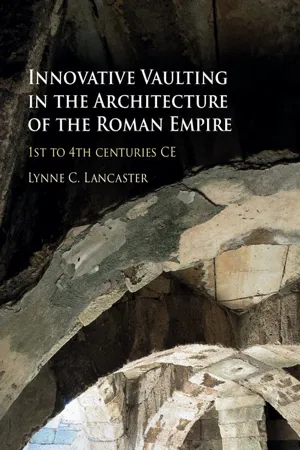
Innovative Vaulting in the Architecture of the Roman Empire
1st to 4th Centuries CE
- English
- PDF
- Available on iOS & Android
Innovative Vaulting in the Architecture of the Roman Empire
1st to 4th Centuries CE
About this book
This book studies six vaulting techniques employed in architecture outside of Rome and asks why they were invented where they were and how they were disseminated. Most of the techniques involve terracotta elements in various forms, such as regular flat bricks, hollow voussoirs, vaulting tubes, and armchair voussoirs. Each one is traced geographically via GIS mapping, the results of which are analysed in relation to chronology, geography, and historical context. The most common building type in which the techniques appear is the bath, demonstrating its importance as a catalyst for technological innovation. This book also explores trade networks, the pottery industry, and military movements in relation to building construction, revealing how architectural innovation was influenced by wide ranging cultural factors, many of which stemmed from local influences rather than imperial intervention. Additional resources including extensive searchable databases with bibliographical data and colour illustrations available at www.cambridge.org/vaulting.
Frequently asked questions
- Essential is ideal for learners and professionals who enjoy exploring a wide range of subjects. Access the Essential Library with 800,000+ trusted titles and best-sellers across business, personal growth, and the humanities. Includes unlimited reading time and Standard Read Aloud voice.
- Complete: Perfect for advanced learners and researchers needing full, unrestricted access. Unlock 1.4M+ books across hundreds of subjects, including academic and specialized titles. The Complete Plan also includes advanced features like Premium Read Aloud and Research Assistant.
Please note we cannot support devices running on iOS 13 and Android 7 or earlier. Learn more about using the app.
Information
Table of contents
- Cover
- Half title
- Title
- Copyright
- Dedication
- Epigraph
- Contents
- List of Figures
- List of Tables
- List of Web Figures
- List of Web Catalogs
- Preface
- 1 Introduction
- 2 Opus Caementicium
- 3 Barrel Vaults of Brick
- 4 Complex Vault Forms of Brick
- 5 Vaulting Tubes
- 6 Hollow Voussoirs
- 7 Vaulting Ribs of Armchair Voussoirs
- 8 Vault Behavior and Structural Form
- 9 Vaulting Techniques in Context
- Notes
- Works Cited
- Index